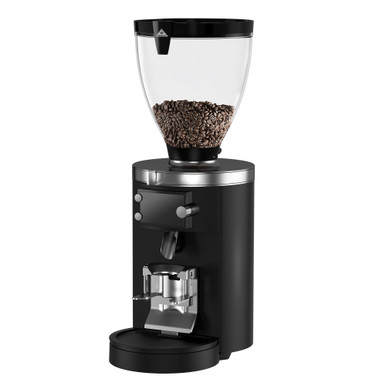Comparison of Timed Grinding vs Grind by Weight Capabilities
I’m Ryan from Prima. Today we’re talking about the practical differences between Grind by Weight technology vs traditional Grind by Time for commercial espresso. For an in-depth overview of the Mahlkonig grinders we’re discussing today, be sure to visit our individual product listings.
What is Grind-by-Time?
First, let’s briefly cover the basic operations of each platform: Grind by Time has been the standard way of dosing dry grounds from an espresso grinder for many decades. By programming the machine to grind for a set number of seconds and 1/10s or even 100ths of a second, we can very effectively hit a desired dose weight each time we grind. For years, this technology has helped make espresso shots much more consistent compared to dosing by volume inside a basket.
Grind-by-Weight
Grind by Weight (or GbW) functionality completely does away with programmable grind time, and instead allows the user to program the dose by weight in increments of 1/10g. GbW grinders accomplish this through the integration of a load cell, which is basically a scale, into the portafilter fork. As the grinder begins to grind, the weight of grounds falling into the basket is tracked in real time, and an advanced algorithm learns from previous cycles in order to stop grinding at precisely the right moment to ensure a consistent dose weight within a margin of 1/10th g.
What Does This Mean For A Cafe?
When we adjust grind size on any espresso grinder, we also in effect change the speed of grinding. As burrs move closer together for a finer grind, the coffee is cut more and is being forced through an ever tighter gap, which decreases the output over a given period. If we adjust coarser, moving the burrs further apart, the coffee is processed increasingly faster because it is being cut less and because its escape route is widening. What this translates to with Grind by Time platforms is the dose weight changing any time grind size is adjusted. In order to maintain consistency, a Barista must then compensate by increasing or decreasing grind time in order to meet the desired dose weight. Even if you’re really in tune with a particular grinder, it can take 2-3 attempts, and wasted doses of coffee, in order to dial in to your original dose weight. Not only does this waste time, this also wastes a significant amount of coffee, and therefore money.
Grind by Weight technology streamlines the process of dialing in by automatically maintaining the programmed dose weight regardless of the grind setting. No matter how dramatically you change the grind size, the grinder will always dose the same amount of grounds, negating any need to reprogram the machine. This, in effect, saves a Barista a full 1-2 minutes and 2-3 doses of coffee for every time the grind is adjusted throughout the day. Grind by Weight is a greater investment up front, but well worth it when compared with the long-term savings in labor and coffee waste.
As much as we love to preach about the wonders of Grind by weight, if you’re operating a low-volume cafe or if your budget is constrained, a Grind by Weight grinder may not make economical sense - these grinders aren’t cheap! For anyone currently dosing grounds by volume into a basket without any time or weight measurements, stepping up to a modestly priced timed-dosing grinder will offer enormous improvement in shot consistency and quality.
The Mahlkonig E65S GbW and E80S GbW grinders also have a number of other upgrades compared to their timed grinding counterparts. For more info on the differences between these platforms, check out our Video Overview of the Mahlkonig Espresso Grinder Line.
Thanks for watching!







